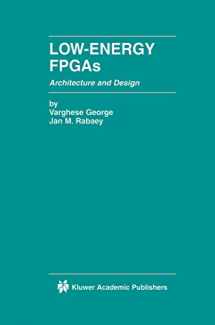
Low-Energy FPGAs ― Architecture and Design (The Springer International Series in Engineering and Computer Science, 625)
ISBN-13:
9780792374282
ISBN-10:
0792374282
Edition:
2001
Author:
Jan M. Rabaey, Varghese George
Publication date:
2001
Publisher:
Springer
Format:
Hardcover
192 pages
Category:
Drafting & Presentation
,
Architecture
FREE US shipping
Book details
ISBN-13:
9780792374282
ISBN-10:
0792374282
Edition:
2001
Author:
Jan M. Rabaey, Varghese George
Publication date:
2001
Publisher:
Springer
Format:
Hardcover
192 pages
Category:
Drafting & Presentation
,
Architecture
Summary
Low-Energy FPGAs ― Architecture and Design (The Springer International Series in Engineering and Computer Science, 625) (ISBN-13: 9780792374282 and ISBN-10: 0792374282), written by authors
Jan M. Rabaey, Varghese George, was published by Springer in 2001.
With an overall rating of 4.1 stars, it's a notable title among other
Drafting & Presentation
(Architecture) books. You can easily purchase or rent Low-Energy FPGAs ― Architecture and Design (The Springer International Series in Engineering and Computer Science, 625) (Hardcover) from BooksRun,
along with many other new and used
Drafting & Presentation
books
and textbooks.
And, if you're looking to sell your copy, our current buyback offer is $0.3.
Description
Low-Energy FPGAs: Architecture and Design is a primary resource for both researchers and practicing engineers in the field of digital circuit design. The book addresses the energy consumption of Field-Programmable Gate Arrays (FPGAs). FPGAs are becoming popular as embedded components in computing platforms. The programmability of the FPGA can be used to customize implementations of functions on an application basis. This leads to performance gains, and enables reuse of expensive silicon. Chapter 1 provides an overview of digital circuit design and FPGAs. Chapter 2 looks at the implication of deep-submicron technology onFPGA power dissipation. Chapter 3 describes the exploration environment to guide and evaluate design decisions. Chapter 4 discusses the architectural optimization process to evaluate the trade-offs between the flexibility of the architecture, and the effect on the performance metrics. Chapter 5 reviews different circuit techniques to reduce the performance overhead of some of the dominant components. Chapter 6 shows methods to configure FPGAs to minimize the programming overhead. Chapter 7 addresses the physical realization of some of the critical components and the final implementation of a specific low-energy FPGA. Chapter 8 compares the prototype array to an equivalent commercial architecture.


We would LOVE it if you could help us and other readers by reviewing the book
Book review

Congratulations! We have received your book review.
{user}
{createdAt}
by {truncated_author}


